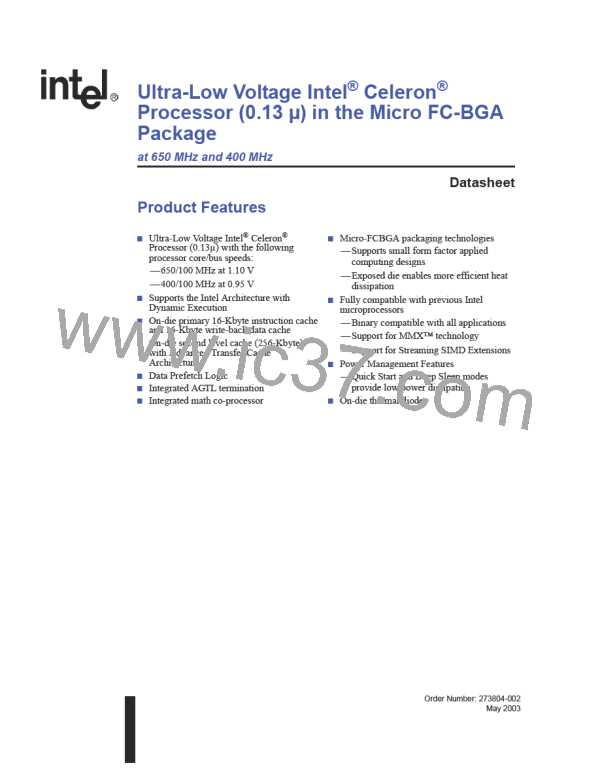Ultra-Low Voltage Intel® Celeron® Processor — 650 MHz and 400 MHz
8.1.20
8.1.21
8.1.22
DEP[7:0]# (I/O - AGTL)
The DEP[7:0]# (Data Bus ECC Protection) signals provide optional ECC protection for the data
bus. They are driven by the agent responsible for driving D[63:0]#, and must be connected to the
appropriate pins/balls on both agents on the system bus if they are used. During power-on
configuration, DEP[7:0]# signals may be enabled for ECC checking or disabled for no checking.
DRDY# (I/O - AGTL)
The DRDY# (Data Ready) signal is asserted by the data driver on each data transfer, indicating
valid data on the data bus. In a multi-cycle data transfer, DRDY# may be deasserted to insert idle
clocks. This signal must be connected to the appropriate pins/balls on both agents on the system
bus.
DPSLP# (I - 1.5 V Tolerant)
The DPSLP# (Deep Sleep) signal, when asserted in the Quick Start state, causes the processor to
enter the Deep Sleep state. In order to return to the Quick Start state BCLK, BCLK# must be
running and the DPSLP# pin must be deasserted.
8.1.23
8.1.24
EDGCTRLP (I-Analog)
The EDGCTRLP (Edge Rate Control) signal is used to configure the edge rate of the AGTL output
buffers. Connect the signal to VSS with a 110-Ω, 1% resistor.
FERR# (O - 1.5 V Tolerant Open-drain)
The FERR# (Floating-point Error) signal is asserted when the processor detects an unmasked
floating-point error. FERR# is similar to the ERROR# signal on the Intel 387 coprocessor, and it is
included for compatibility with systems using DOS-type floating-point error reporting.
8.1.25
8.1.26
FLUSH# (I - 1.5 V Tolerant)
When the FLUSH# (Flush) input signal is asserted, the processor writes back all internal cache
lines in the Modified state and invalidates all internal cache lines. At the completion of a flush
operation, the processor issues a Flush Acknowledge transaction. The processor stops caching any
new data while the FLUSH# signal remains asserted.
On the active-to-inactive transition of RESET#, each processor bus agent samples FLUSH# to
determine its power-on configuration.
HIT# (I/O - AGTL), HITM# (I/O - AGTL)
The HIT# (Snoop Hit) and HITM# (Hit Modified) signals convey transaction snoop operation
results, and must be connected to the appropriate pins/balls on both agents on the system bus.
Either bus agent may assert both HIT# and HITM# together to indicate that it requires a snoop stall,
which may be continued by reasserting HIT# and HITM# together.
Datasheet
73

 INTEL [ INTEL ]
INTEL [ INTEL ]